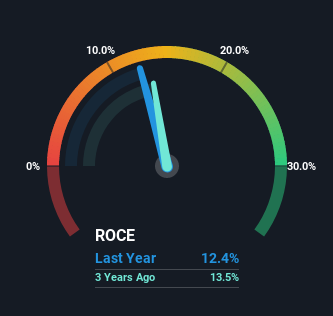- Switzerland
- /
- Machinery
- /
- SWX:SRAIL
Stadler Rail's (VTX:SRAIL) Returns On Capital Not Reflecting Well On The Business
If we want to find a potential multi-bagger, often there are underlying trends that can provide clues. In a perfect world, we'd like to see a company investing more capital into its business and ideally the returns earned from that capital are also increasing. If you see this, it typically means it's a company with a great business model and plenty of profitable reinvestment opportunities. Having said that, from a first glance at Stadler Rail (VTX:SRAIL) we aren't jumping out of our chairs at how returns are trending, but let's have a deeper look.
Return On Capital Employed (ROCE): What Is It?
If you haven't worked with ROCE before, it measures the 'return' (pre-tax profit) a company generates from capital employed in its business. Analysts use this formula to calculate it for Stadler Rail:
Return on Capital Employed = Earnings Before Interest and Tax (EBIT) ÷ (Total Assets - Current Liabilities)
0.12 = CHF185m ÷ (CHF4.4b - CHF2.9b) (Based on the trailing twelve months to December 2022).
Thus, Stadler Rail has an ROCE of 12%. That's a relatively normal return on capital, and it's around the 15% generated by the Machinery industry.
View our latest analysis for Stadler Rail

Above you can see how the current ROCE for Stadler Rail compares to its prior returns on capital, but there's only so much you can tell from the past. If you're interested, you can view the analysts predictions in our free report on analyst forecasts for the company.
SWOT Analysis for Stadler Rail
- Debt is not viewed as a risk.
- Earnings declined over the past year.
- Dividend is low compared to the top 25% of dividend payers in the Machinery market.
- Annual earnings are forecast to grow faster than the Swiss market.
- Current share price is below our estimate of fair value.
- Dividends are not covered by earnings.
- Revenue is forecast to grow slower than 20% per year.
What The Trend Of ROCE Can Tell Us
On the surface, the trend of ROCE at Stadler Rail doesn't inspire confidence. Around five years ago the returns on capital were 19%, but since then they've fallen to 12%. On the other hand, the company has been employing more capital without a corresponding improvement in sales in the last year, which could suggest these investments are longer term plays. It's worth keeping an eye on the company's earnings from here on to see if these investments do end up contributing to the bottom line.
Another thing to note, Stadler Rail has a high ratio of current liabilities to total assets of 66%. This can bring about some risks because the company is basically operating with a rather large reliance on its suppliers or other sorts of short-term creditors. While it's not necessarily a bad thing, it can be beneficial if this ratio is lower.
The Bottom Line On Stadler Rail's ROCE
Bringing it all together, while we're somewhat encouraged by Stadler Rail's reinvestment in its own business, we're aware that returns are shrinking. Unsurprisingly then, the total return to shareholders over the last three years has been flat. Therefore based on the analysis done in this article, we don't think Stadler Rail has the makings of a multi-bagger.
One more thing to note, we've identified 3 warning signs with Stadler Rail and understanding them should be part of your investment process.
While Stadler Rail may not currently earn the highest returns, we've compiled a list of companies that currently earn more than 25% return on equity. Check out this free list here.
New: Manage All Your Stock Portfolios in One Place
We've created the ultimate portfolio companion for stock investors, and it's free.
• Connect an unlimited number of Portfolios and see your total in one currency
• Be alerted to new Warning Signs or Risks via email or mobile
• Track the Fair Value of your stocks
Have feedback on this article? Concerned about the content? Get in touch with us directly. Alternatively, email editorial-team (at) simplywallst.com.
This article by Simply Wall St is general in nature. We provide commentary based on historical data and analyst forecasts only using an unbiased methodology and our articles are not intended to be financial advice. It does not constitute a recommendation to buy or sell any stock, and does not take account of your objectives, or your financial situation. We aim to bring you long-term focused analysis driven by fundamental data. Note that our analysis may not factor in the latest price-sensitive company announcements or qualitative material. Simply Wall St has no position in any stocks mentioned.
About SWX:SRAIL
Stadler Rail
Through its subsidiaries, engages in the manufacture and sale of trains in Switzerland, Germany, Austria, Western and Eastern Europe, the Americas, the CIS countries, and internationally.
High growth potential with adequate balance sheet.
Similar Companies
Market Insights
Community Narratives




